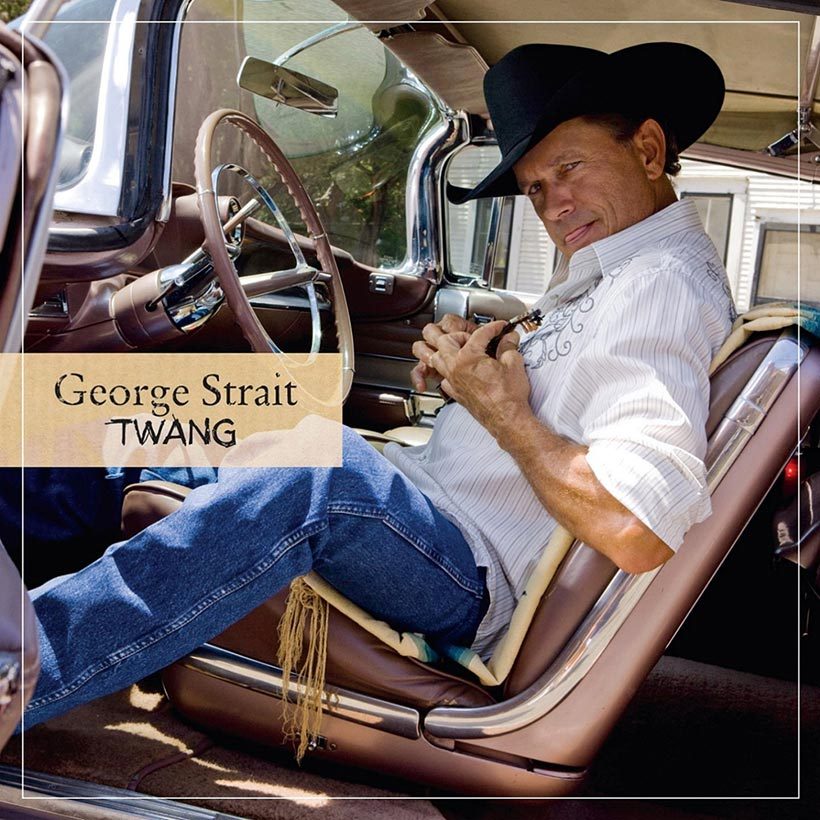‘Twang’: George Strait’s ‘Honky-Tonk Floor-Burner’ Of An Album
‘Twang’ took George Strait to the top of the charts yet again, furthering the enduring Texan hero’s crossover appeal in the digital age.

In the summer of 2009, George Strait landed at No.1 on America’s country and pop charts with a resounding Twang. That was the title of the 26th studio album by an enduring Texan hero who was already 28 years into his reign.
Hitting the top of the country album charts was nothing more or less than what George always did, and Twang was the 19th of those 26 releases to achieve the feat. But in the digital era, Strait was now growing used to making the crossover onto the Billboard 200 as well. Twang marked the fourth time he’d made that mainstream leap, first secured in 1997 with the subsequent CMA Album Of The Year, Carrying Your Love With Me. It happened again with 2005’s Somewhere Down In Texas, and in 2008 with another CMA champion that also won a Grammy for Best Country Album, Troubadour.
‘We just dove into it head first’
Twang was released on August 11, 2009, supported by a home-state show in Houston that week featuring guests Sugarland and Blake Shelton. The album arrived at a time when hitmakers from different musical worlds, such as Demi Lovato and Fabolous, had recently owned the No.1 spot, but this was a season in which country’s finest were especially prominent. Strait’s new release succeeded Sugarland’s Live On The Inside at the top of the Billboard 200, before giving way to Reba McEntire’s Keep On Loving You.
Strait co-produced Twang with Nashville mainstay Tony Brown, who had taken over as his studio collaborator from fellow country stalwart Jimmy Bowen on 1993’s double-platinum-selling Easy Come, Easy Go. The outrider for the new set was the opening release, “Living For The Night,” George’s first co-write to be chosen as a single. Its mellow groove combined traditional instrumentation with a subtle string accompaniment befitting the lovelorn lyric, helping it rise to No.2 on the Hot Country Songs chart.
The song was penned with his regular compadre Dean Dillon and with son George “Bubba” Strait, Jr. Born in the year of his father’s first hit, 1981, Bubba was now turning 18 and would emerge on Twang as a notable and enduring member of George’s creative inner circle. In a video promoting the album, the master hitmaker explained how his son helped him to rediscover the songwriting muse.
“My son started toying with the idea of trying to write a little bit, so that kind of gave me the bug to write, also,” he said. “So we started writing a few things together, and I kind of got into it again. I had the idea for ‘Living For The Night’ for a long, long time, but I just never got around to sitting down and trying to write it.”
A ‘honky-tonk floor-burner’
“Bubba” would receive four co-writes on Twang, and his father three. Dillon, the Nashville Songwriters Hall Of Fame inductee whose previous co-writes for Strait included such gems as “The Chair”, “Ocean Front Property,” “I’ve Come To Expect It From You,” and “If I Were Me,” had his own observations about the ascension of Strait, Jr, with “Living For The Night.” “Bubba comes at it from a little different angle, which is great,” he said. “You always want that other perspective. We just dove into it head first and spent about two to three hours writing it.”
The second single was the album’s opening track and title song, a rambunctious singalong with the narrator heading for the jukebox to hear his favourite time-honoured country sound. The “honky-tonk floor-burner”, as one review called it, was written by Americana notable Jim Lauderdale with Kendell Marvell and Jimmy Ritchey.
As the album continued its chart run, Strait headed out on the Twang Tour early in 2010, starting with a January 22 show in Baltimore that featured both of those opening singles among many of his hits, and covers of Merle Haggard’s “Seashores Of Old Mexico” and Johnny Cash’s “Folsom Prison Blues.” Dates continued until early May, when he returned to Texas to conclude the tour in San Antonio.
‘Would you change your tune?’
Lauderdale also co-wrote the third release from the album, the breezy “I Gotta Get To You,” which spent two weeks at No.3 in June 2010. Dillon, daughter Jessie Jo, and another in-demand hit country composer, Casey Beathard, came up with the final single, the low-key and string-laden “The Breath You Take.” Strait’s sympathetic treatment of a reflective lyric struck a chord, and it became Twang’s third top tenner, reaching No.6 and winning a Grammy nomination.
On an album full of familiar pleasures, Strait got back to his roots and raised a few eyebrows with “El Rey,” a closing track that he sang entirely in Spanish. It was written by the late Mexican songwriting hero responsible for more than a thousand songs in the country’s rancheras tradition, José Alfredo Jiménez.
Listen to the best of George Strait on Apple Music and Spotify.
“Do these self-penned songs explode like bottle rockets in the vast West Texas sky? No,” wrote Entertainment Weekly of Twang. “They sound like George Strait songs, of course. But look, the dude’s cut 57 No.1 hits. Would you change your tune?” PopMatters said that the record “adds 13 more songs to his legacy, without detracting from it in any way”, adding, “Some of these songs are as good as anything he’s done, which is saying something.”
Buy or stream Twang.












